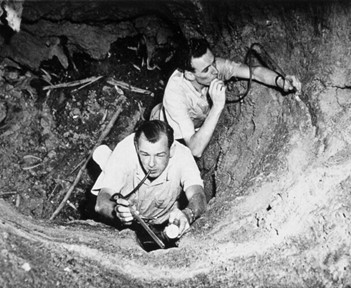The conclusion is therefore justified that the cases of ‘mysterious disease’ occurring in Queensland and New South Wales are caused by the same virus as acute poliomyelitis. Anton Breinl, 19181
Clinical diagnostic technology has steadily improved since the revolutionary advancements in medicine and biology of the 19th Century, led by Louis Pasteur. By the time the SARS-CoV-2 virus emerged in late 2019, causing the COVID-19 pandemic, laboratory testing could confirm and characterise a novel pathogen within hours or days. In the past, identifying new diseases was slower, often leading to speculation about their causes and origins. This article examines a historical case from Australia to explore how emerging diseases transition from sudden crises to recognised public health threats. In most cases, this has avoided ill-informed speculation about the cause of the disease and its origin. We examine a historical example from Australia to understand how newly emerging infectious diseases move from emergency to accepted background threats to human health.
During World War I, a new infectious disease arose in rural Australia. ‘Australian X disease’ involved the nervous system, was often lethal and there was no apparent means of transmission or effective treatment. Public concern was driven by its similarity to a lethal infection predominating in children, polio, as noted in the initial quote. After two summers, Australian X disease disappeared only to reoccur a few years later.2,3
Monkeys injected with neurological tissue from encephalitis patients with Australian X disease by Breinl in Townsville and Cleland et al. in Sydney developed fatal infections.1,4 Cleland et al. also managed to infect a sheep, a calf and a horse with brain tissue from their monkeys. Breinl believed the agent he had recovered was related to poliovirus. However, Cleland et al. disagreed.1,4 and when Perdrau re-examined some of the histology sections made by Cleland et al. from the brains of patients with Australian X disease, he noted similarities between these and those from animals infected with Louping Ill virus.4,5 Louping Ill virus is a tick-borne virus primarily affecting cattle and sheep in parts of Europe but it rarely infects humans and is now grouped with the ‘encephalitic’ flaviviruses to which Murray Valley encephalitis virus belongs.6 However, Louping Ill virus has never been detected in Australia.
There were two further outbreaks of disease resembling Australian X disease, in 1922 and 1925, but it remains unclear why no further cases were reported between 1925 and 1951.3 While the 1930s included the Depression, during which occasional deaths due to neurological disease may not have been reported, the medical staff accompanying troops throughout Australia during World War II would have been expected to have noticed cases of Australian X disease in troops for whom they were responsible or in surrounding civilian populations.
It was not until 1951 that a virus was isolated from patients with Australian X disease, and the infection was named Murray Valley encephalitis (MVE). French recovered the virus from three patients by inoculating brain tissue onto the chorioallantoic membrane of eggs.7 Miles et al. also recovered the virus from a patient by inoculating tissue intracerebrally into day-old mice.8 While technically easier, this method of virus isolation and performing neutralisation tests required enormous numbers of animals. Doherty’s isolation of 24 arboviruses, new to science in the 1960s and 70s, utilised 5–10 000 suckling mice each year.9
Serology demonstrated that MVE virus was related to the Japanese B encephalitis virus (now designated Japanese encephalitis) included in the Group B arbovirus family (now flaviviruses). Further characterisation of the new virus had to be performed in the United States because it was not possible to import antisera against viruses that were not known to be circulating in Australia.
The combination of serology and virus recovery from patients should have convinced all observers that the MVE virus was responsible for the recent encephalitis outbreak. However, in 1950, the Australian government released the myxomatosis virus to control/eradicate rabbits that were devastating farmland. This partially successful attempt at biological control had the unfortunate consequence of creating a belief among some in the non-scientific community ‘that the myxo had got out’ and that the rabbit virus was responsible for MVE. There were anecdotal accounts of tourists passing money for petrol to service station attendants through barely opened car windows to avoid infection with myxomatosis, even though it does not infect humans. Direct human experimentation was used to prove the point and reassure the public. Three of Australia’s leading scientists in the 1950s, McFarlane-Burnet from the Walter and Eliza Hall Institute, Fenner from the Australian National University and Clunies-Ross, Chairman of Commonwealth Scientific and Industrial Research Organisation (CSIRO), inoculated themselves with large doses of myxomatosis virus and suffered no ill effects. Richard Casey, the Australian Minister for Science, announced these preliminary results in federal parliament, aiming to reassure the public that MVE was not due to myxomatosis. Fenner later recounted to the first senior that he did not know what they would have done if they had become ill, demonstrating his supreme confidence in his actions without any research committee oversight.11
It is unclear what triggered the community alarm about the outbreak of MVE in 1951. Contributing factors may have been that this was a previously unknown virus and the almost concurrent release of myxomatosis virus to control rabbits. Although it had caused no direct effect on human health, the community would have been aware of the debacle surrounding the introduction of cane toads (Bufu marinus) to north Queensland in 1935 as a form of biological control of sugar cane beetles.12
Since 1951, there have been small numbers of cases of Murray Valley encephalitis reported most years with occasional outbreaks, for example, in 1974 and 2011.13 Despite its geographically specific name, most MVE cases occur in northern Australia during periods of increased rainfall. The annual average from 2018 to 2023 was three cases (as reported in the National Notifiable Diseases Scheme). There are no commercial tests for the diagnosis of MVE. It is unclear what effect having to refer samples to central state government laboratories has on the testing regime and disease reporting.
MVE has been joined recently (2022) by the closely related Japanese Encephalitis virus (JEV) which has spread south from the Torres Strait into mainland Australia.14 The rapid spread of Japanese encephalitis cases through eastern Australia and the proximity to pig populations, which are natural hosts of JEV, led to a declaration of a Communicable Disease Incident of National Significance (CDINS).15 Animal infection studies have suggested that JEV vaccine might provide some cross-protection against infection against MVE and given the public’s expectation that new viruses will be matched with new vaccines in less than a year after the success of RNA vaccines during the COVID-19 pandemic, it is worth considering if preparations should be made to employ a JEV vaccine in the face of a serious outbreak of MVE in the future.
The era of fertile eggs and suckling mice for virus isolation has passed and even the cell culture systems that superseded them are less important as an aid to diagnosis than a decade or so ago. The evolving field of metagenomics can identify infectious agents even if we do not know how to grow them in a laboratory setting. This approach is rapid (hours to a day) and provides the genomic information to inform the development of diagnostic tests and vaccines. The next few years will reveal how much improvements in software, like Artificial Intelligence, can make to this process.
Unlike MVE, it will not take 50 years to identify the cause of the subsequent emerging infectious disease due to the improved genomic technology. However, the next disease to emerge in Australia may not be as extensive or life-threatening as COVID-19 and the public health response required may be very different. In the rush to technology, we should not lose sight of the critical role of essential public health interventions.

Figure 1: Staff from the Walter and Eliza Hall Institute collecting mosquitoes near the Murray River in Victoria in 1951 during an outbreak of Murray Valley Encephalitis. WEHI photo from https://www.wehi.edu.au/about/history/murray-valley-encephalitis
Contributors: JA and GDS are responsible for the entire manuscript.
Conflicts of interest statement: The authors do not claim any conflicts of interest.
Funding: The authors are either current or former employees of the Australian Defence Organisation and are retired US and Australian Army medical officers but did not receive any specific funding for this study.
Disclaimer: The opinions expressed are those of the authors and do not necessarily reflect those of the Australian Defence Force or the U.S. Department of Defense.



